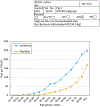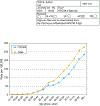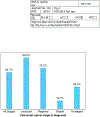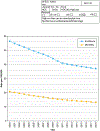Screening for Colorectal Cancer
- PMID: 35501176
- PMCID: PMC9167799
- DOI: 10.1016/j.hoc.2022.02.001
Screening for Colorectal Cancer
Abstract
Colorectal cancer (CRC) is the second-leading cause of cancer death in the United States. Screening reduces CRC incidence and mortality. 2021 US Preventive Service Task Force (USPSTF) guidelines and available evidence support routine screening from ages 45 to 75, and individualized consideration of screening ages 76 to 85. USPSTF guidelines recommend annual guaiac fecal occult blood testing, annual fecal immunochemical testing (FIT), annual to every 3-year multitarget stool DNA-FIT, every 5-year sigmoidoscopy, every 10-year sigmoidoscopy with annual FIT, every 5-year computed tomographic colonography, and every 10-year colonoscopy as options for screening. The "best test is the one that gets done."
Keywords: Colorectal cancer; Early detection; Incidence; Mortality; Prevention; Screening.
Published by Elsevier Inc.
Conflict of interest statement
Disclosure The author serves as a local site investigator for 2 trials investigating blood-based biomarkers for colorectal cancer screening sponsored by Freenome Holdings, Inc and Epigenomics AG. The author serves as a paid consultant to Guardant Health and CellMax Life, which are developing blood-based biomarkers for colorectal cancer screening.
Figures






Similar articles
-
Estimation of Benefits, Burden, and Harms of Colorectal Cancer Screening Strategies: Modeling Study for the US Preventive Services Task Force.JAMA. 2016 Jun 21;315(23):2595-609. doi: 10.1001/jama.2016.6828. JAMA. 2016. PMID: 27305518 Free PMC article.
-
USPSTF colorectal cancer screening guidelines: an extended look at multi-year interval testing.Am J Manag Care. 2016 Feb 1;22(2):e77-81. Am J Manag Care. 2016. PMID: 26881323
-
Optimal Strategies for Colorectal Cancer Screening.Curr Treat Options Oncol. 2022 Apr;23(4):474-493. doi: 10.1007/s11864-022-00962-4. Epub 2022 Mar 22. Curr Treat Options Oncol. 2022. PMID: 35316477 Free PMC article. Review.
-
Screening for Colorectal Cancer: Updated Evidence Report and Systematic Review for the US Preventive Services Task Force.JAMA. 2021 May 18;325(19):1978-1998. doi: 10.1001/jama.2021.4417. JAMA. 2021. PMID: 34003220
-
Colorectal cancer screening with faecal immunochemical testing, sigmoidoscopy or colonoscopy: a clinical practice guideline.BMJ. 2019 Oct 2;367:l5515. doi: 10.1136/bmj.l5515. BMJ. 2019. PMID: 31578196
Cited by
-
Association of Serum Proteases and Acute Phase Factors Levels with Survival Outcomes in Patients with Colorectal Cancer.Cancers (Basel). 2024 Jul 6;16(13):2471. doi: 10.3390/cancers16132471. Cancers (Basel). 2024. PMID: 39001534 Free PMC article.
-
miR-455/GREM1 axis promotes colorectal cancer progression and liver metastasis by affecting PI3K/AKT pathway and inducing M2 macrophage polarization.Cancer Cell Int. 2024 Jul 5;24(1):235. doi: 10.1186/s12935-024-03422-1. Cancer Cell Int. 2024. PMID: 38970064 Free PMC article.
-
Epidemiology of colorectal cancer: A review with special emphasis on India.Indian J Gastroenterol. 2025 Apr;44(2):142-153. doi: 10.1007/s12664-024-01726-8. Epub 2025 Feb 10. Indian J Gastroenterol. 2025. PMID: 39928255 Free PMC article. Review.
-
The Evolving Role of Chemotherapy in the Management of Pleural Malignancies: Current Evidence and Future Directions.Cancers (Basel). 2025 Jun 25;17(13):2143. doi: 10.3390/cancers17132143. Cancers (Basel). 2025. PMID: 40647443 Free PMC article. Review.
-
Examining the Sustainability of Core Capacity and Evidence-Based Interventions for FIT-Based CRC Screening: California Colorectal Cancer Control Program.Cancer Control. 2024 Jan-Dec;31:10732748241255218. doi: 10.1177/10732748241255218. Cancer Control. 2024. PMID: 39058902 Free PMC article.
References
-
- Siegel RL, Miller KD, Goding Sauer A, et al. Colorectal cancer statistics, 2020. CA: A Cancer Journal for Clinicians. 2020;0:1–20. - PubMed
-
- Colon and Rectum SEER Incidence and U.S. Mortality Rates by Age at Diagnosis, 2014–2018. In: SEER*Explorer: An interactive website for SEER cancer statistics [Internet]. Surveillance, Epidemiology, and End Results Program, National Cancer Institute. Available at:https://seer.cancer.gov/explorer/application.html?site=20&data_type=9&gr.... Accessed August 27, 2021.
-
- Dekker E, Tanis PJ, Vleugels JLA, Kasi PM, Wallace MB. Colorectal cancer. Lancet. 2019;394(10207):1467–1480. - PubMed
-
- Risk factors and protective factors. In: IARC (2019). Colorectal cancer screening. IARC Handb Cancer Prev. 17:1–300. Available from: http://publications.iarc.fr/573.
Publication types
MeSH terms
Grants and funding
LinkOut - more resources
Full Text Sources
Medical

